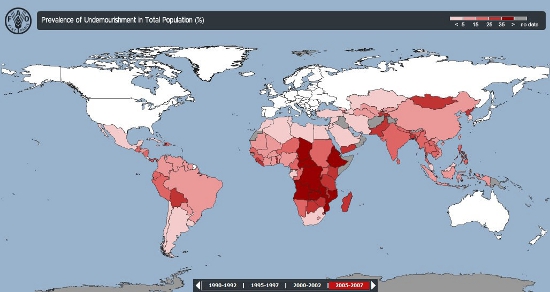The Problem

(Source FAO)
925 million of the nearly 7 billion people on earth are chronically undernourished. World population is expected to hit 9 billion by the middle of this century, with most of the increase in developing nations, and the number of undernourished will increase as well (FAO, 2010). The current and future undernourished population must become able to access and purchase food. How?
There have been many efforts to reduce undernourishment, with varying success. Although there is an effort to help the hungry, the fact remains that there are still 925 million undernourished people. Solutions need to be looked at critically to determine why they aren't working, or, if they are, how to scale the program to impact more people. However, no perfect solution has been formed yet. It will take a combined effort of all types of organizations, governments, and individuals to achieve this goal. Why hasn't this been done long ago?
The food crisis is a very complex problem with many causes. The specific problems are unique to each region and none are easy to solve. The effects of malnourishment are equally complex: reducing the health of the population, decreasing the productivity, and thus trapping the developing nations in a cycle of poverty. The poor workers in these countries do not have the ability to improve their situation and there is no new investment in the nations' economies. Investment is key to economic growth and provides incentives to produce more; without investment the economy cannot grow.The cycle repeats and low investment causes low growth which increases poverty and reduces investment even more. This cycle has to be addressed by a complex and adaptable solution.
The major contributor to undernourishment is poverty. People who do not have enough money to purchase food for themselves and their family often get stuck in their situation. They do not have enough money or resources to improve their situation though creating businesses or securing higher-paying jobs. Then they are disadvantaged by this and remain in poverty, generally over multiple generations. On a broad scale, this cycle leads to a lack of investment, and economic growth. The economic disparity between the rich and the poor just serves to perpetuate this cycle. Poor people who cannot afford food are ignored. The market system is not enough to provide all people with foods. The primary problems with markets are the lack of access to markets in rural areas, poor transportation routes, waste due to poor storage and corrupt middlemen, and prices that neither the producers nor the consumers can afford.

(Source http://www.freefoto.com/preview/09-08-8?ffid=09-08-8)
Another major factor is the amount of food produced. Even though there is strong evidence that the world produces more than enough food for all the people, the agricultural system as a whole needs to change to eliminate hunger (Leathers, p. 133). The current farming practices are generally unsustainable and degrade the environment, causing deforestation and destruction of natural ecosystems. More agricultural technologies must be incorporated to produce more food sustainably in the places it is needed.
Undernourishment impacts people's health, causing more disease, less production, and many other health problems. Children are especially susceptible, in the first 1000 days of life undernourishment causes irreparable damage and mental retardation (World Food Program, 2010). In addition to caloric starvation, problems arise from having insufficient quantities of any essential nutrient, common deficiencies include Vitamin A and iodine (Leathers & Foster, 2009; Bassett & Winter-Nelson, 2010). Improving health by improving the food eaten will greatly increase the quality of life and increase the productivity of the poor.
The issue that underlies all of these facets of the problem is the lack of empowerment of the poor. They are disadvantaged and trapped in the cycle of poverty. They have no power to fix their situation and improve their lives on their own. This stems from other issues such as low education levels, poor health, lack of access to capital for business, and inefficient agricultural practices. The poor have little to no representation in the governments. This is especially true for women and the gender gap creates more problems.
Giving food aid does help to relieve the hunger temporarily, but it does nothing to fix the underlying issues. To truly impact the world, there needs to be a concerted effort to provide solutions for the long term that will create development and empower the poor with the tools they need. The specific causes of hunger vary significantly in different regions. There are different reasons why people starve in cities than rural areas, in a war-torn country in Africa than in central China, and between flood victims and isolated villages. Because of this, large-scale top-down solutions often fail because they do not appreciate the regional peculiarities and so the programs do not reach their intended goal. Instead, a more bottom-up approach that critically examines each problem and the region it affects is needed to enable a solution.
(Photo courtesy of Heather McDonald)
Leathers, H., & Foster, P. (2009). The world food problem: toward ending undernutrition in the third world. Colorado: Lynne Rienner Publishers Inc.
Hunger. (2010) World Food Programme. Retrieved November 20, 2010 from http://www.wfp.org/hunger/faqs.
Bassett, T. & Winter-Nelson, A. (2010). Atlas of world hunger. Chicago: The University of Chicago Press.
Food and Agriculture Organization of the United Nations (FAO). FAO, 2010. Retrieved 30 November, 2010. www.fao.org.